Factors Influencing Employee Motivation in Organizations Report
VerifiedAdded on 2022/12/30
|10
|2632
|28
Report
AI Summary
This report delves into the critical topic of employee motivation, a core element of people management. It explores various factors that significantly impact employee motivation, including reward and recognition systems, opportunities for development, leadership styles, work-life balance, and the overall work environment. The report also examines motivational theories, specifically focusing on Maslow's Hierarchy of Needs and Herzberg's Two-Factor Theory, to understand how these frameworks can be applied to enhance employee productivity and performance. Furthermore, the report includes a reflective essay that outlines the student's learning experience, skill development, challenges faced, and insights gained during the research and writing process. The conclusion summarizes the key findings, emphasizing the importance of effective people management strategies in fostering a motivated and productive workforce. The report is a comprehensive analysis of employee motivation and its practical implications in organizational settings.
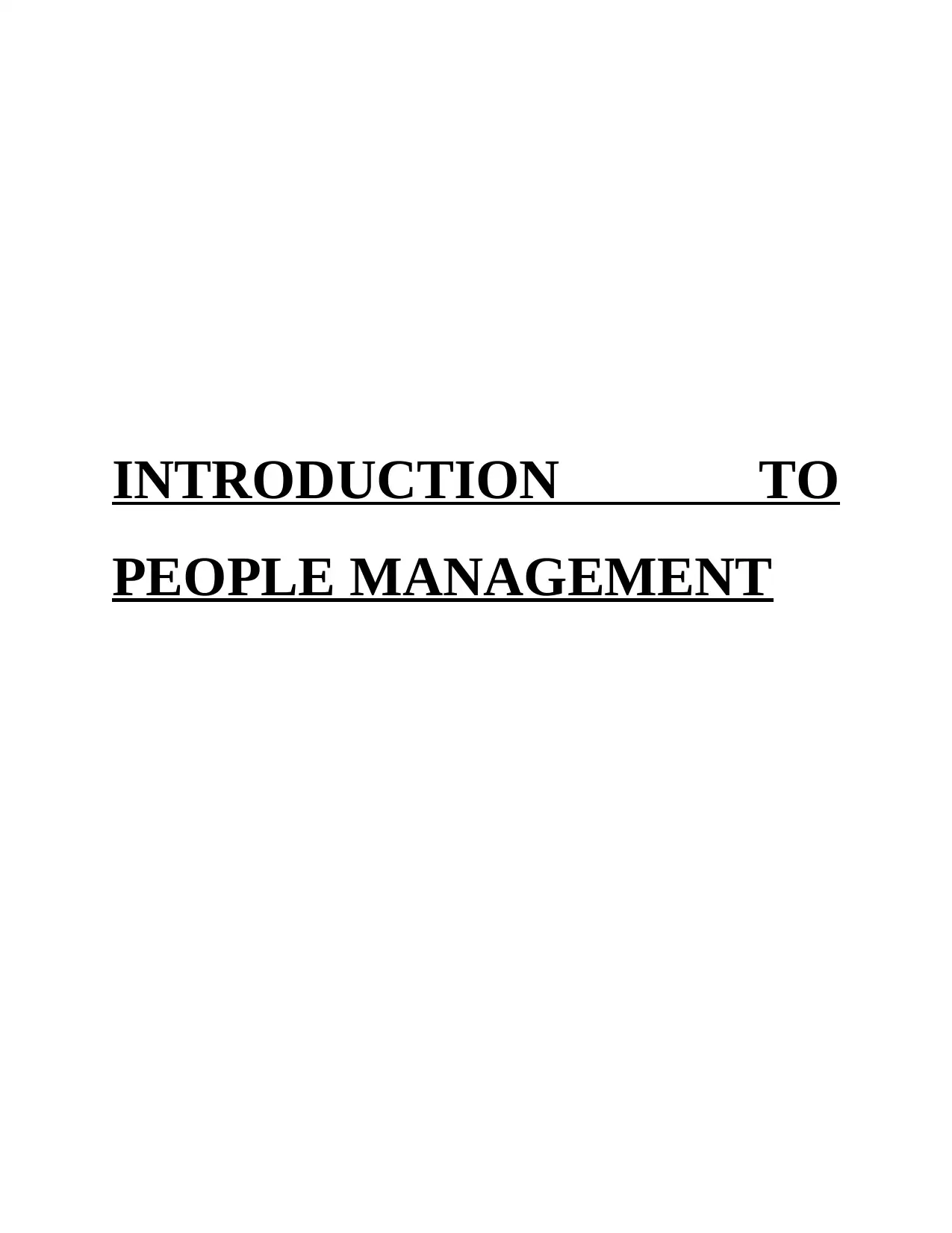
INTRODUCTION TO
PEOPLE MANAGEMENT
PEOPLE MANAGEMENT
Paraphrase This Document
Need a fresh take? Get an instant paraphrase of this document with our AI Paraphraser
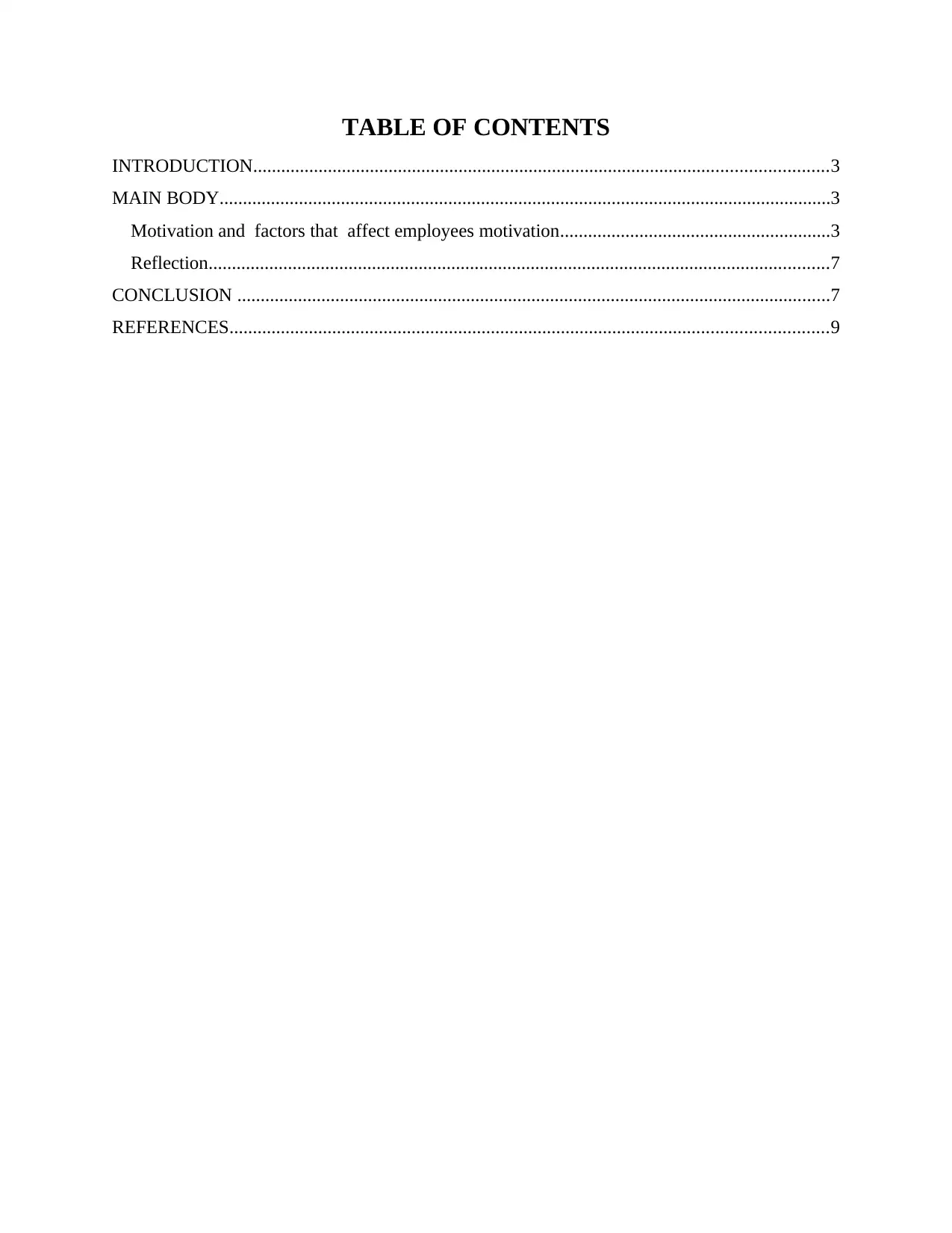
TABLE OF CONTENTS
INTRODUCTION...........................................................................................................................3
MAIN BODY...................................................................................................................................3
Motivation and factors that affect employees motivation..........................................................3
Reflection.....................................................................................................................................7
CONCLUSION ...............................................................................................................................7
REFERENCES................................................................................................................................9
INTRODUCTION...........................................................................................................................3
MAIN BODY...................................................................................................................................3
Motivation and factors that affect employees motivation..........................................................3
Reflection.....................................................................................................................................7
CONCLUSION ...............................................................................................................................7
REFERENCES................................................................................................................................9

⊘ This is a preview!⊘
Do you want full access?
Subscribe today to unlock all pages.

Trusted by 1+ million students worldwide
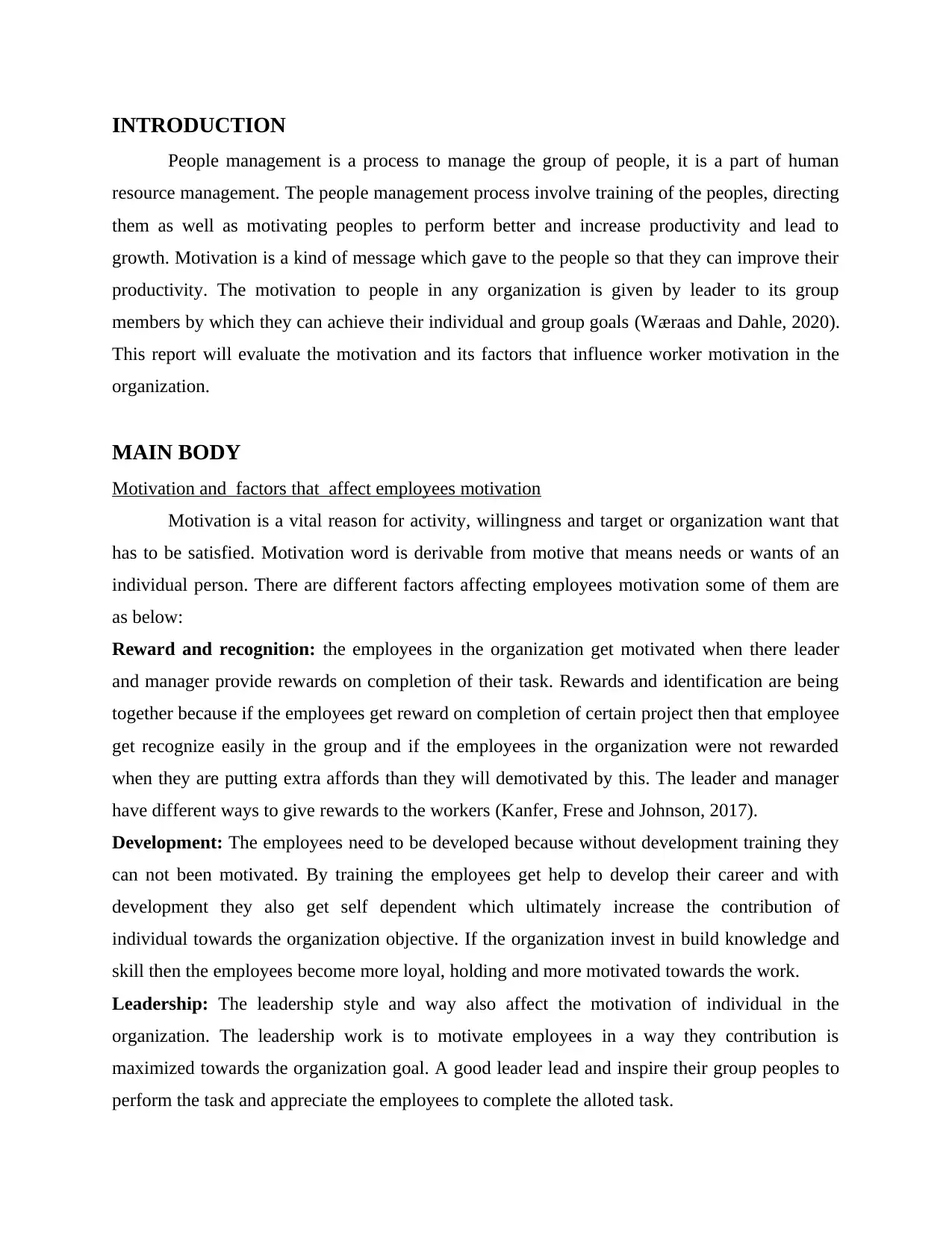
INTRODUCTION
People management is a process to manage the group of people, it is a part of human
resource management. The people management process involve training of the peoples, directing
them as well as motivating peoples to perform better and increase productivity and lead to
growth. Motivation is a kind of message which gave to the people so that they can improve their
productivity. The motivation to people in any organization is given by leader to its group
members by which they can achieve their individual and group goals (Wæraas and Dahle, 2020).
This report will evaluate the motivation and its factors that influence worker motivation in the
organization.
MAIN BODY
Motivation and factors that affect employees motivation
Motivation is a vital reason for activity, willingness and target or organization want that
has to be satisfied. Motivation word is derivable from motive that means needs or wants of an
individual person. There are different factors affecting employees motivation some of them are
as below:
Reward and recognition: the employees in the organization get motivated when there leader
and manager provide rewards on completion of their task. Rewards and identification are being
together because if the employees get reward on completion of certain project then that employee
get recognize easily in the group and if the employees in the organization were not rewarded
when they are putting extra affords than they will demotivated by this. The leader and manager
have different ways to give rewards to the workers (Kanfer, Frese and Johnson, 2017).
Development: The employees need to be developed because without development training they
can not been motivated. By training the employees get help to develop their career and with
development they also get self dependent which ultimately increase the contribution of
individual towards the organization objective. If the organization invest in build knowledge and
skill then the employees become more loyal, holding and more motivated towards the work.
Leadership: The leadership style and way also affect the motivation of individual in the
organization. The leadership work is to motivate employees in a way they contribution is
maximized towards the organization goal. A good leader lead and inspire their group peoples to
perform the task and appreciate the employees to complete the alloted task.
People management is a process to manage the group of people, it is a part of human
resource management. The people management process involve training of the peoples, directing
them as well as motivating peoples to perform better and increase productivity and lead to
growth. Motivation is a kind of message which gave to the people so that they can improve their
productivity. The motivation to people in any organization is given by leader to its group
members by which they can achieve their individual and group goals (Wæraas and Dahle, 2020).
This report will evaluate the motivation and its factors that influence worker motivation in the
organization.
MAIN BODY
Motivation and factors that affect employees motivation
Motivation is a vital reason for activity, willingness and target or organization want that
has to be satisfied. Motivation word is derivable from motive that means needs or wants of an
individual person. There are different factors affecting employees motivation some of them are
as below:
Reward and recognition: the employees in the organization get motivated when there leader
and manager provide rewards on completion of their task. Rewards and identification are being
together because if the employees get reward on completion of certain project then that employee
get recognize easily in the group and if the employees in the organization were not rewarded
when they are putting extra affords than they will demotivated by this. The leader and manager
have different ways to give rewards to the workers (Kanfer, Frese and Johnson, 2017).
Development: The employees need to be developed because without development training they
can not been motivated. By training the employees get help to develop their career and with
development they also get self dependent which ultimately increase the contribution of
individual towards the organization objective. If the organization invest in build knowledge and
skill then the employees become more loyal, holding and more motivated towards the work.
Leadership: The leadership style and way also affect the motivation of individual in the
organization. The leadership work is to motivate employees in a way they contribution is
maximized towards the organization goal. A good leader lead and inspire their group peoples to
perform the task and appreciate the employees to complete the alloted task.
Paraphrase This Document
Need a fresh take? Get an instant paraphrase of this document with our AI Paraphraser
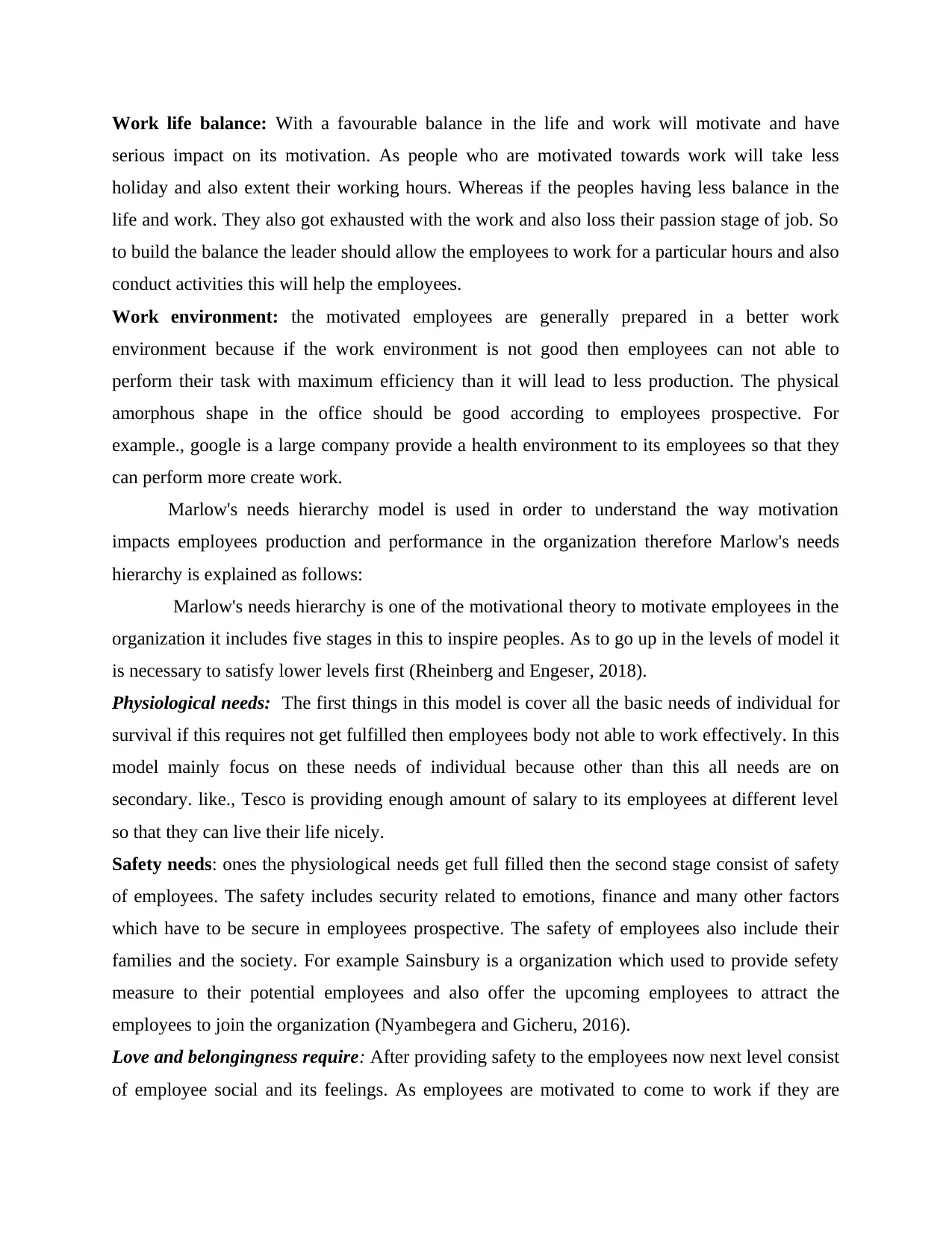
Work life balance: With a favourable balance in the life and work will motivate and have
serious impact on its motivation. As people who are motivated towards work will take less
holiday and also extent their working hours. Whereas if the peoples having less balance in the
life and work. They also got exhausted with the work and also loss their passion stage of job. So
to build the balance the leader should allow the employees to work for a particular hours and also
conduct activities this will help the employees.
Work environment: the motivated employees are generally prepared in a better work
environment because if the work environment is not good then employees can not able to
perform their task with maximum efficiency than it will lead to less production. The physical
amorphous shape in the office should be good according to employees prospective. For
example., google is a large company provide a health environment to its employees so that they
can perform more create work.
Marlow's needs hierarchy model is used in order to understand the way motivation
impacts employees production and performance in the organization therefore Marlow's needs
hierarchy is explained as follows:
Marlow's needs hierarchy is one of the motivational theory to motivate employees in the
organization it includes five stages in this to inspire peoples. As to go up in the levels of model it
is necessary to satisfy lower levels first (Rheinberg and Engeser, 2018).
Physiological needs: The first things in this model is cover all the basic needs of individual for
survival if this requires not get fulfilled then employees body not able to work effectively. In this
model mainly focus on these needs of individual because other than this all needs are on
secondary. like., Tesco is providing enough amount of salary to its employees at different level
so that they can live their life nicely.
Safety needs: ones the physiological needs get full filled then the second stage consist of safety
of employees. The safety includes security related to emotions, finance and many other factors
which have to be secure in employees prospective. The safety of employees also include their
families and the society. For example Sainsbury is a organization which used to provide sefety
measure to their potential employees and also offer the upcoming employees to attract the
employees to join the organization (Nyambegera and Gicheru, 2016).
Love and belongingness require: After providing safety to the employees now next level consist
of employee social and its feelings. As employees are motivated to come to work if they are
serious impact on its motivation. As people who are motivated towards work will take less
holiday and also extent their working hours. Whereas if the peoples having less balance in the
life and work. They also got exhausted with the work and also loss their passion stage of job. So
to build the balance the leader should allow the employees to work for a particular hours and also
conduct activities this will help the employees.
Work environment: the motivated employees are generally prepared in a better work
environment because if the work environment is not good then employees can not able to
perform their task with maximum efficiency than it will lead to less production. The physical
amorphous shape in the office should be good according to employees prospective. For
example., google is a large company provide a health environment to its employees so that they
can perform more create work.
Marlow's needs hierarchy model is used in order to understand the way motivation
impacts employees production and performance in the organization therefore Marlow's needs
hierarchy is explained as follows:
Marlow's needs hierarchy is one of the motivational theory to motivate employees in the
organization it includes five stages in this to inspire peoples. As to go up in the levels of model it
is necessary to satisfy lower levels first (Rheinberg and Engeser, 2018).
Physiological needs: The first things in this model is cover all the basic needs of individual for
survival if this requires not get fulfilled then employees body not able to work effectively. In this
model mainly focus on these needs of individual because other than this all needs are on
secondary. like., Tesco is providing enough amount of salary to its employees at different level
so that they can live their life nicely.
Safety needs: ones the physiological needs get full filled then the second stage consist of safety
of employees. The safety includes security related to emotions, finance and many other factors
which have to be secure in employees prospective. The safety of employees also include their
families and the society. For example Sainsbury is a organization which used to provide sefety
measure to their potential employees and also offer the upcoming employees to attract the
employees to join the organization (Nyambegera and Gicheru, 2016).
Love and belongingness require: After providing safety to the employees now next level consist
of employee social and its feelings. As employees are motivated to come to work if they are
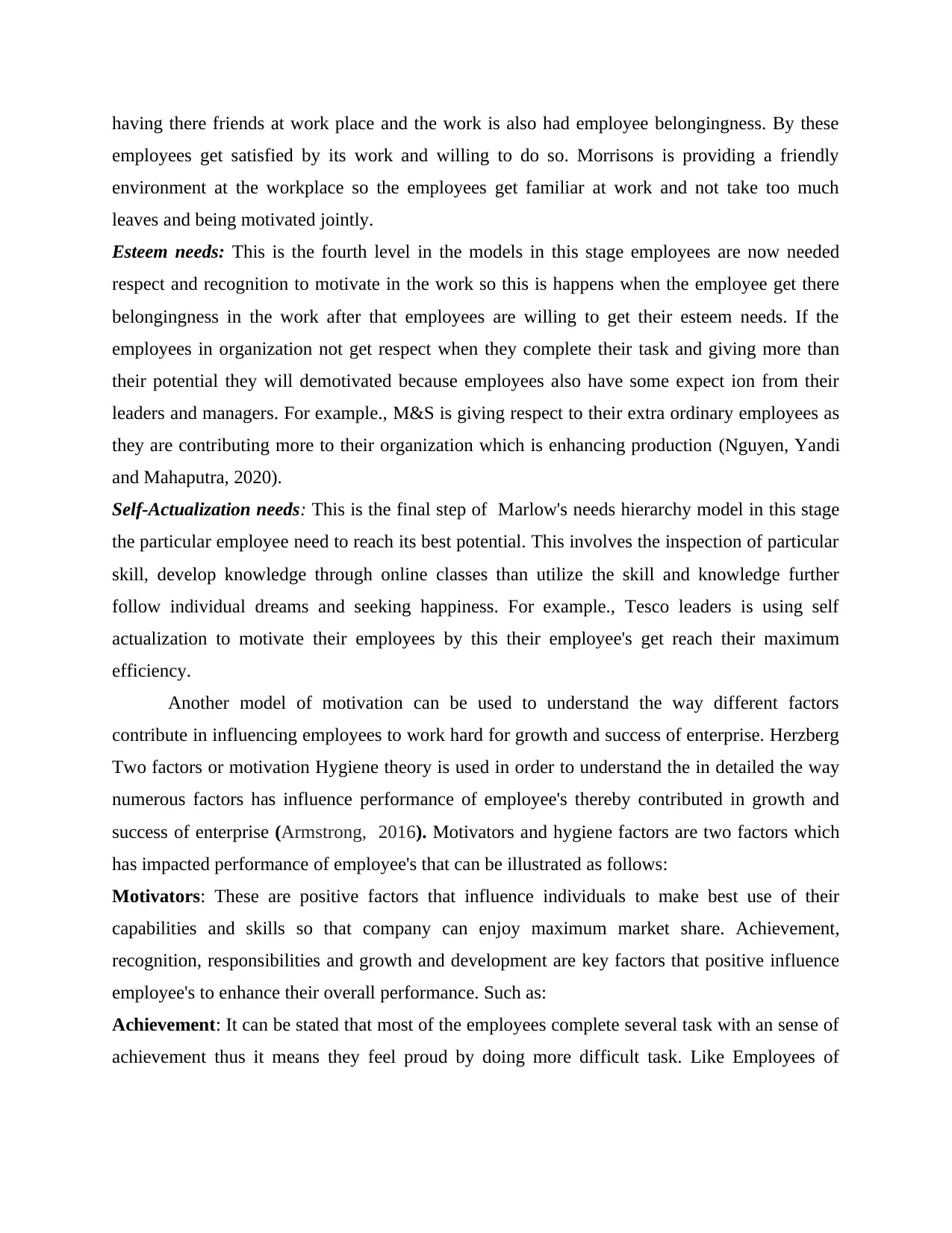
having there friends at work place and the work is also had employee belongingness. By these
employees get satisfied by its work and willing to do so. Morrisons is providing a friendly
environment at the workplace so the employees get familiar at work and not take too much
leaves and being motivated jointly.
Esteem needs: This is the fourth level in the models in this stage employees are now needed
respect and recognition to motivate in the work so this is happens when the employee get there
belongingness in the work after that employees are willing to get their esteem needs. If the
employees in organization not get respect when they complete their task and giving more than
their potential they will demotivated because employees also have some expect ion from their
leaders and managers. For example., M&S is giving respect to their extra ordinary employees as
they are contributing more to their organization which is enhancing production (Nguyen, Yandi
and Mahaputra, 2020).
Self-Actualization needs: This is the final step of Marlow's needs hierarchy model in this stage
the particular employee need to reach its best potential. This involves the inspection of particular
skill, develop knowledge through online classes than utilize the skill and knowledge further
follow individual dreams and seeking happiness. For example., Tesco leaders is using self
actualization to motivate their employees by this their employee's get reach their maximum
efficiency.
Another model of motivation can be used to understand the way different factors
contribute in influencing employees to work hard for growth and success of enterprise. Herzberg
Two factors or motivation Hygiene theory is used in order to understand the in detailed the way
numerous factors has influence performance of employee's thereby contributed in growth and
success of enterprise (Armstrong, 2016). Motivators and hygiene factors are two factors which
has impacted performance of employee's that can be illustrated as follows:
Motivators: These are positive factors that influence individuals to make best use of their
capabilities and skills so that company can enjoy maximum market share. Achievement,
recognition, responsibilities and growth and development are key factors that positive influence
employee's to enhance their overall performance. Such as:
Achievement: It can be stated that most of the employees complete several task with an sense of
achievement thus it means they feel proud by doing more difficult task. Like Employees of
employees get satisfied by its work and willing to do so. Morrisons is providing a friendly
environment at the workplace so the employees get familiar at work and not take too much
leaves and being motivated jointly.
Esteem needs: This is the fourth level in the models in this stage employees are now needed
respect and recognition to motivate in the work so this is happens when the employee get there
belongingness in the work after that employees are willing to get their esteem needs. If the
employees in organization not get respect when they complete their task and giving more than
their potential they will demotivated because employees also have some expect ion from their
leaders and managers. For example., M&S is giving respect to their extra ordinary employees as
they are contributing more to their organization which is enhancing production (Nguyen, Yandi
and Mahaputra, 2020).
Self-Actualization needs: This is the final step of Marlow's needs hierarchy model in this stage
the particular employee need to reach its best potential. This involves the inspection of particular
skill, develop knowledge through online classes than utilize the skill and knowledge further
follow individual dreams and seeking happiness. For example., Tesco leaders is using self
actualization to motivate their employees by this their employee's get reach their maximum
efficiency.
Another model of motivation can be used to understand the way different factors
contribute in influencing employees to work hard for growth and success of enterprise. Herzberg
Two factors or motivation Hygiene theory is used in order to understand the in detailed the way
numerous factors has influence performance of employee's thereby contributed in growth and
success of enterprise (Armstrong, 2016). Motivators and hygiene factors are two factors which
has impacted performance of employee's that can be illustrated as follows:
Motivators: These are positive factors that influence individuals to make best use of their
capabilities and skills so that company can enjoy maximum market share. Achievement,
recognition, responsibilities and growth and development are key factors that positive influence
employee's to enhance their overall performance. Such as:
Achievement: It can be stated that most of the employees complete several task with an sense of
achievement thus it means they feel proud by doing more difficult task. Like Employees of
⊘ This is a preview!⊘
Do you want full access?
Subscribe today to unlock all pages.

Trusted by 1+ million students worldwide
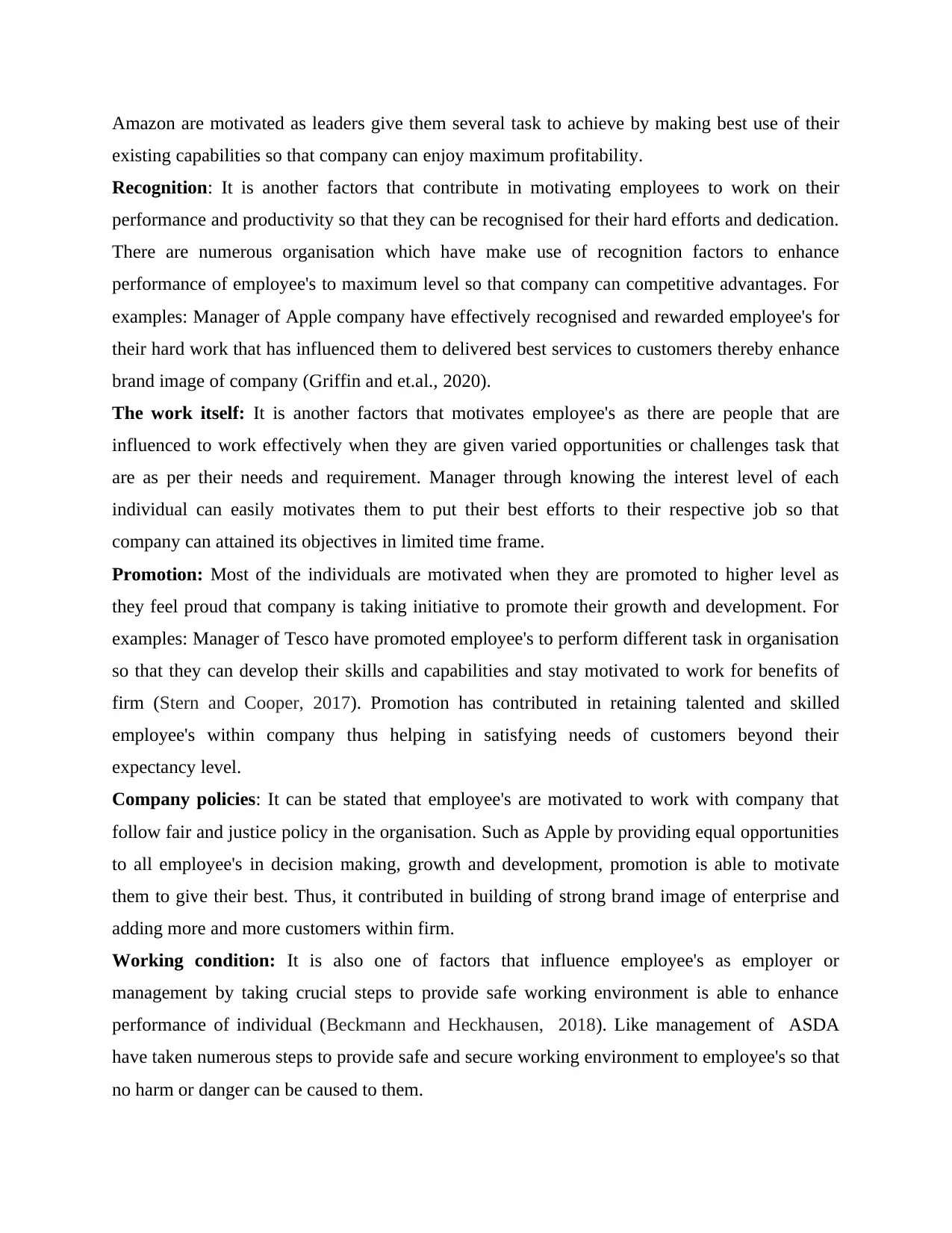
Amazon are motivated as leaders give them several task to achieve by making best use of their
existing capabilities so that company can enjoy maximum profitability.
Recognition: It is another factors that contribute in motivating employees to work on their
performance and productivity so that they can be recognised for their hard efforts and dedication.
There are numerous organisation which have make use of recognition factors to enhance
performance of employee's to maximum level so that company can competitive advantages. For
examples: Manager of Apple company have effectively recognised and rewarded employee's for
their hard work that has influenced them to delivered best services to customers thereby enhance
brand image of company (Griffin and et.al., 2020).
The work itself: It is another factors that motivates employee's as there are people that are
influenced to work effectively when they are given varied opportunities or challenges task that
are as per their needs and requirement. Manager through knowing the interest level of each
individual can easily motivates them to put their best efforts to their respective job so that
company can attained its objectives in limited time frame.
Promotion: Most of the individuals are motivated when they are promoted to higher level as
they feel proud that company is taking initiative to promote their growth and development. For
examples: Manager of Tesco have promoted employee's to perform different task in organisation
so that they can develop their skills and capabilities and stay motivated to work for benefits of
firm (Stern and Cooper, 2017). Promotion has contributed in retaining talented and skilled
employee's within company thus helping in satisfying needs of customers beyond their
expectancy level.
Company policies: It can be stated that employee's are motivated to work with company that
follow fair and justice policy in the organisation. Such as Apple by providing equal opportunities
to all employee's in decision making, growth and development, promotion is able to motivate
them to give their best. Thus, it contributed in building of strong brand image of enterprise and
adding more and more customers within firm.
Working condition: It is also one of factors that influence employee's as employer or
management by taking crucial steps to provide safe working environment is able to enhance
performance of individual (Beckmann and Heckhausen, 2018). Like management of ASDA
have taken numerous steps to provide safe and secure working environment to employee's so that
no harm or danger can be caused to them.
existing capabilities so that company can enjoy maximum profitability.
Recognition: It is another factors that contribute in motivating employees to work on their
performance and productivity so that they can be recognised for their hard efforts and dedication.
There are numerous organisation which have make use of recognition factors to enhance
performance of employee's to maximum level so that company can competitive advantages. For
examples: Manager of Apple company have effectively recognised and rewarded employee's for
their hard work that has influenced them to delivered best services to customers thereby enhance
brand image of company (Griffin and et.al., 2020).
The work itself: It is another factors that motivates employee's as there are people that are
influenced to work effectively when they are given varied opportunities or challenges task that
are as per their needs and requirement. Manager through knowing the interest level of each
individual can easily motivates them to put their best efforts to their respective job so that
company can attained its objectives in limited time frame.
Promotion: Most of the individuals are motivated when they are promoted to higher level as
they feel proud that company is taking initiative to promote their growth and development. For
examples: Manager of Tesco have promoted employee's to perform different task in organisation
so that they can develop their skills and capabilities and stay motivated to work for benefits of
firm (Stern and Cooper, 2017). Promotion has contributed in retaining talented and skilled
employee's within company thus helping in satisfying needs of customers beyond their
expectancy level.
Company policies: It can be stated that employee's are motivated to work with company that
follow fair and justice policy in the organisation. Such as Apple by providing equal opportunities
to all employee's in decision making, growth and development, promotion is able to motivate
them to give their best. Thus, it contributed in building of strong brand image of enterprise and
adding more and more customers within firm.
Working condition: It is also one of factors that influence employee's as employer or
management by taking crucial steps to provide safe working environment is able to enhance
performance of individual (Beckmann and Heckhausen, 2018). Like management of ASDA
have taken numerous steps to provide safe and secure working environment to employee's so that
no harm or danger can be caused to them.
Paraphrase This Document
Need a fresh take? Get an instant paraphrase of this document with our AI Paraphraser
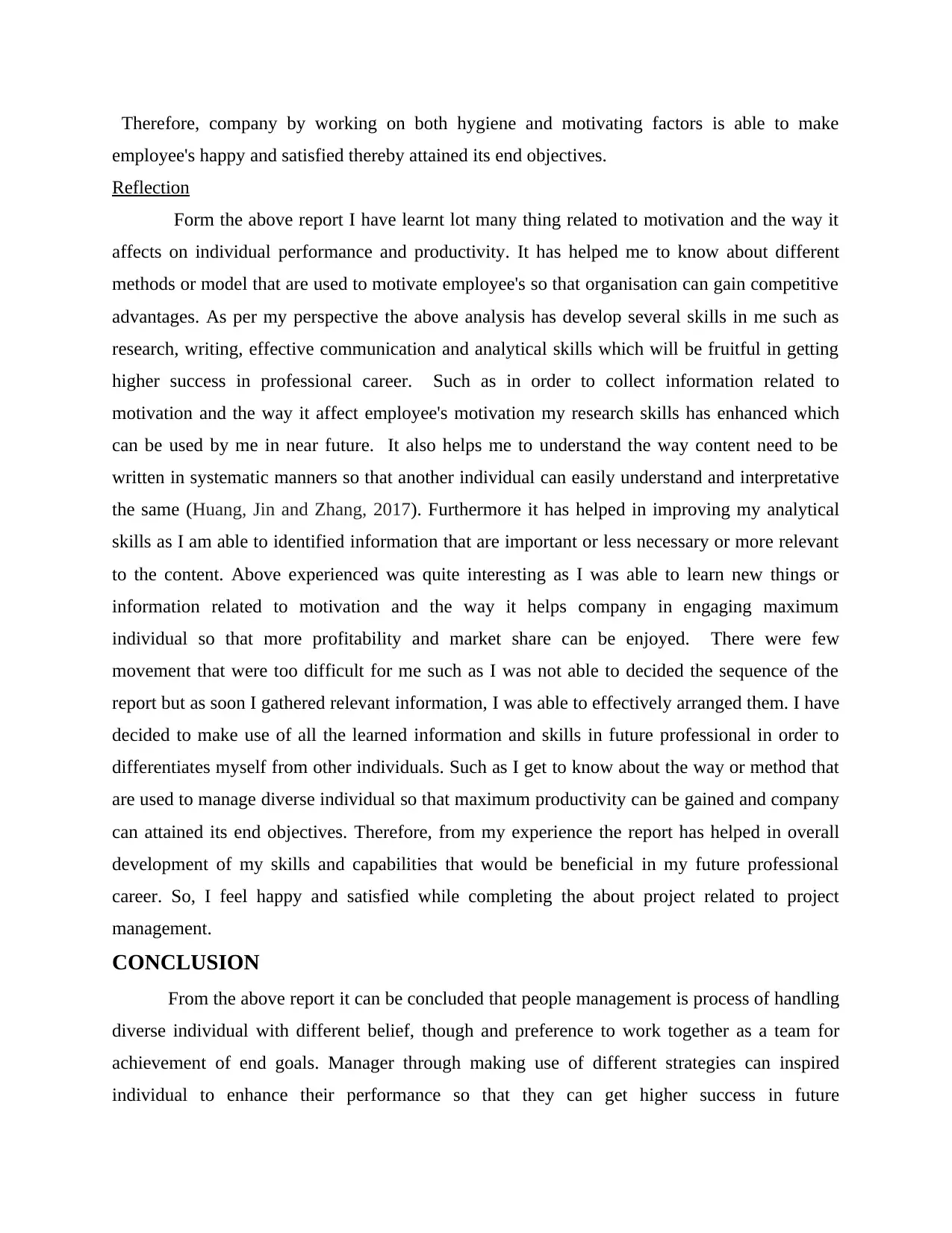
Therefore, company by working on both hygiene and motivating factors is able to make
employee's happy and satisfied thereby attained its end objectives.
Reflection
Form the above report I have learnt lot many thing related to motivation and the way it
affects on individual performance and productivity. It has helped me to know about different
methods or model that are used to motivate employee's so that organisation can gain competitive
advantages. As per my perspective the above analysis has develop several skills in me such as
research, writing, effective communication and analytical skills which will be fruitful in getting
higher success in professional career. Such as in order to collect information related to
motivation and the way it affect employee's motivation my research skills has enhanced which
can be used by me in near future. It also helps me to understand the way content need to be
written in systematic manners so that another individual can easily understand and interpretative
the same (Huang, Jin and Zhang, 2017). Furthermore it has helped in improving my analytical
skills as I am able to identified information that are important or less necessary or more relevant
to the content. Above experienced was quite interesting as I was able to learn new things or
information related to motivation and the way it helps company in engaging maximum
individual so that more profitability and market share can be enjoyed. There were few
movement that were too difficult for me such as I was not able to decided the sequence of the
report but as soon I gathered relevant information, I was able to effectively arranged them. I have
decided to make use of all the learned information and skills in future professional in order to
differentiates myself from other individuals. Such as I get to know about the way or method that
are used to manage diverse individual so that maximum productivity can be gained and company
can attained its end objectives. Therefore, from my experience the report has helped in overall
development of my skills and capabilities that would be beneficial in my future professional
career. So, I feel happy and satisfied while completing the about project related to project
management.
CONCLUSION
From the above report it can be concluded that people management is process of handling
diverse individual with different belief, though and preference to work together as a team for
achievement of end goals. Manager through making use of different strategies can inspired
individual to enhance their performance so that they can get higher success in future
employee's happy and satisfied thereby attained its end objectives.
Reflection
Form the above report I have learnt lot many thing related to motivation and the way it
affects on individual performance and productivity. It has helped me to know about different
methods or model that are used to motivate employee's so that organisation can gain competitive
advantages. As per my perspective the above analysis has develop several skills in me such as
research, writing, effective communication and analytical skills which will be fruitful in getting
higher success in professional career. Such as in order to collect information related to
motivation and the way it affect employee's motivation my research skills has enhanced which
can be used by me in near future. It also helps me to understand the way content need to be
written in systematic manners so that another individual can easily understand and interpretative
the same (Huang, Jin and Zhang, 2017). Furthermore it has helped in improving my analytical
skills as I am able to identified information that are important or less necessary or more relevant
to the content. Above experienced was quite interesting as I was able to learn new things or
information related to motivation and the way it helps company in engaging maximum
individual so that more profitability and market share can be enjoyed. There were few
movement that were too difficult for me such as I was not able to decided the sequence of the
report but as soon I gathered relevant information, I was able to effectively arranged them. I have
decided to make use of all the learned information and skills in future professional in order to
differentiates myself from other individuals. Such as I get to know about the way or method that
are used to manage diverse individual so that maximum productivity can be gained and company
can attained its end objectives. Therefore, from my experience the report has helped in overall
development of my skills and capabilities that would be beneficial in my future professional
career. So, I feel happy and satisfied while completing the about project related to project
management.
CONCLUSION
From the above report it can be concluded that people management is process of handling
diverse individual with different belief, though and preference to work together as a team for
achievement of end goals. Manager through making use of different strategies can inspired
individual to enhance their performance so that they can get higher success in future
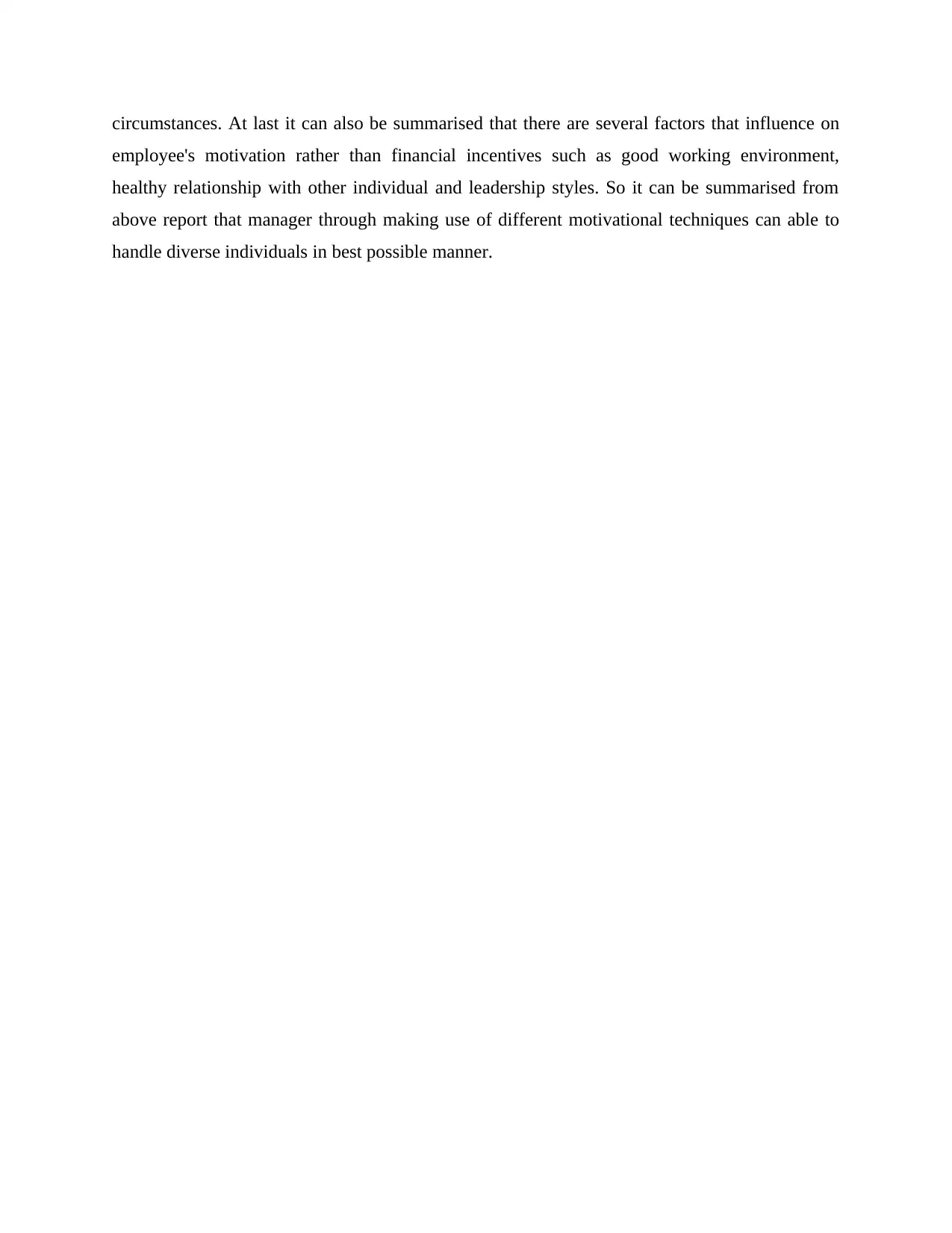
circumstances. At last it can also be summarised that there are several factors that influence on
employee's motivation rather than financial incentives such as good working environment,
healthy relationship with other individual and leadership styles. So it can be summarised from
above report that manager through making use of different motivational techniques can able to
handle diverse individuals in best possible manner.
employee's motivation rather than financial incentives such as good working environment,
healthy relationship with other individual and leadership styles. So it can be summarised from
above report that manager through making use of different motivational techniques can able to
handle diverse individuals in best possible manner.
⊘ This is a preview!⊘
Do you want full access?
Subscribe today to unlock all pages.

Trusted by 1+ million students worldwide
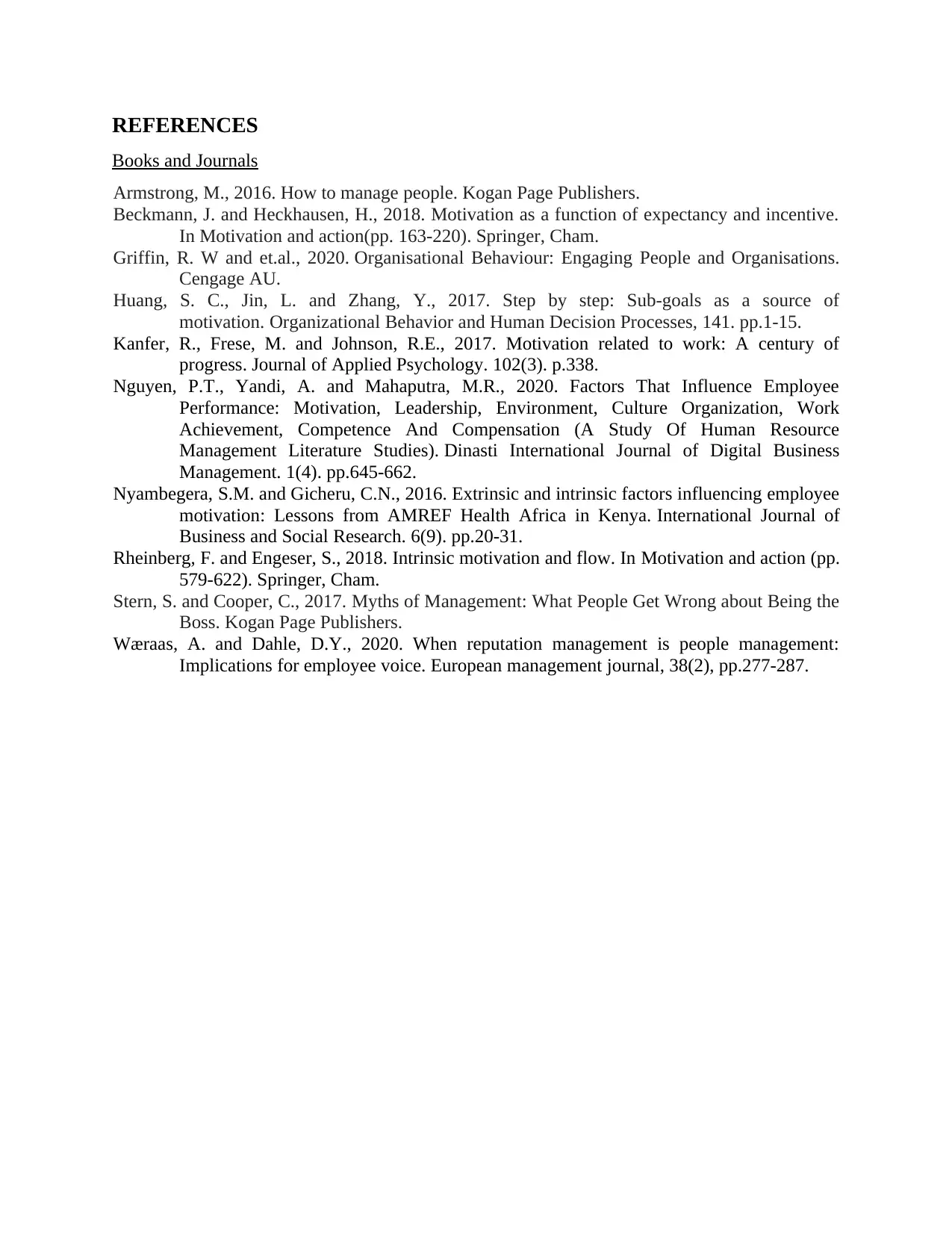
REFERENCES
Books and Journals
Armstrong, M., 2016. How to manage people. Kogan Page Publishers.
Beckmann, J. and Heckhausen, H., 2018. Motivation as a function of expectancy and incentive.
In Motivation and action(pp. 163-220). Springer, Cham.
Griffin, R. W and et.al., 2020. Organisational Behaviour: Engaging People and Organisations.
Cengage AU.
Huang, S. C., Jin, L. and Zhang, Y., 2017. Step by step: Sub-goals as a source of
motivation. Organizational Behavior and Human Decision Processes, 141. pp.1-15.
Kanfer, R., Frese, M. and Johnson, R.E., 2017. Motivation related to work: A century of
progress. Journal of Applied Psychology. 102(3). p.338.
Nguyen, P.T., Yandi, A. and Mahaputra, M.R., 2020. Factors That Influence Employee
Performance: Motivation, Leadership, Environment, Culture Organization, Work
Achievement, Competence And Compensation (A Study Of Human Resource
Management Literature Studies). Dinasti International Journal of Digital Business
Management. 1(4). pp.645-662.
Nyambegera, S.M. and Gicheru, C.N., 2016. Extrinsic and intrinsic factors influencing employee
motivation: Lessons from AMREF Health Africa in Kenya. International Journal of
Business and Social Research. 6(9). pp.20-31.
Rheinberg, F. and Engeser, S., 2018. Intrinsic motivation and flow. In Motivation and action (pp.
579-622). Springer, Cham.
Stern, S. and Cooper, C., 2017. Myths of Management: What People Get Wrong about Being the
Boss. Kogan Page Publishers.
Wæraas, A. and Dahle, D.Y., 2020. When reputation management is people management:
Implications for employee voice. European management journal, 38(2), pp.277-287.
Books and Journals
Armstrong, M., 2016. How to manage people. Kogan Page Publishers.
Beckmann, J. and Heckhausen, H., 2018. Motivation as a function of expectancy and incentive.
In Motivation and action(pp. 163-220). Springer, Cham.
Griffin, R. W and et.al., 2020. Organisational Behaviour: Engaging People and Organisations.
Cengage AU.
Huang, S. C., Jin, L. and Zhang, Y., 2017. Step by step: Sub-goals as a source of
motivation. Organizational Behavior and Human Decision Processes, 141. pp.1-15.
Kanfer, R., Frese, M. and Johnson, R.E., 2017. Motivation related to work: A century of
progress. Journal of Applied Psychology. 102(3). p.338.
Nguyen, P.T., Yandi, A. and Mahaputra, M.R., 2020. Factors That Influence Employee
Performance: Motivation, Leadership, Environment, Culture Organization, Work
Achievement, Competence And Compensation (A Study Of Human Resource
Management Literature Studies). Dinasti International Journal of Digital Business
Management. 1(4). pp.645-662.
Nyambegera, S.M. and Gicheru, C.N., 2016. Extrinsic and intrinsic factors influencing employee
motivation: Lessons from AMREF Health Africa in Kenya. International Journal of
Business and Social Research. 6(9). pp.20-31.
Rheinberg, F. and Engeser, S., 2018. Intrinsic motivation and flow. In Motivation and action (pp.
579-622). Springer, Cham.
Stern, S. and Cooper, C., 2017. Myths of Management: What People Get Wrong about Being the
Boss. Kogan Page Publishers.
Wæraas, A. and Dahle, D.Y., 2020. When reputation management is people management:
Implications for employee voice. European management journal, 38(2), pp.277-287.
1 out of 10
Related Documents
Your All-in-One AI-Powered Toolkit for Academic Success.
+13062052269
info@desklib.com
Available 24*7 on WhatsApp / Email
![[object Object]](/_next/static/media/star-bottom.7253800d.svg)
Unlock your academic potential
Copyright © 2020–2025 A2Z Services. All Rights Reserved. Developed and managed by ZUCOL.





